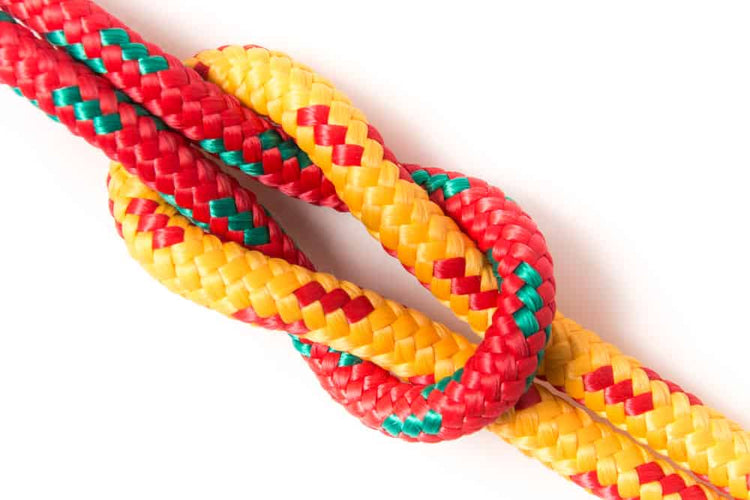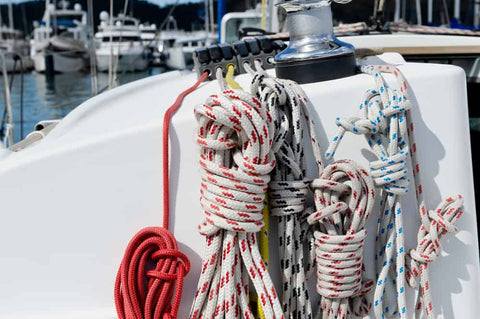Feeling Tied Up? 6 Essential Nautical Knots You Must Know!

Feeling all tied up when it comes to knowing what knots are best for your lines? If you're like me, who once felt this way, they all sounded the same. And tying them proved tricky for me as well.
Throwing knots together is a skill all boaters need to know, so I grabbed some of my sailing buddies who taught me the ropes (pun intended). So if you've got questions about knots, I've got ya covered. Here's what you need to know:
The 3 Types of Knots: What's the Difference?
Nautical knots: Measures how fast your boat is traveling
Wind knots: Measures the speed of the wind
Sailing knots: Every sailor should know a variety of knots whether they're sailing a tall ship, a yacht or a dingy.
Because all sailing knots are nautical in nature, the words "nautical knots" and "sailing knots" are often thrown around liberally.
Even sailors and boaters who understand the true difference use them interchangeably.
For the sake of simplicity, I'm going to focus on the knots we tie.
Is It a Rope or Line?

All sailors and boat owners need to know how to tie a variety of sailing knots in their lines. While we're on the subject, which is it? A rope? A line? What's the difference? Here's another interchangeable word.
According to Boating with Dawsons, many boaters think that these two words are interchangeable: that a rope is a line and a line is a rope. This is not true.
Rope is just a rope unless it's been assigned a job. Much like a border collie needs a job, so does rope.
Once you prepare a rope for a specific task and place it on a boat, it becomes a line, which is labeled for the job at hand ( such as the anchor line or dock line).
The 6 Essential Nautical Knots You Need to Know

My friend David encouraged me to embrace the art of line management. Quite the trickster, he warned if I didn't keep lines correctly coiled and out of the cockpit, they'd entangle my feet and hoist me up the mast, leaving me dangling upside-down.
Well, I didn't want that to happen. So to this day, I take great pride in organizing boats with line management and knot tying skills. While there are hundreds of knots every sailor and boatman should know, these six are the ones I consider absolute must-know knots.
1. Bowline
The bowline is a fixed loop at the end of a rope used for fastening a mooring line. It's also one of the most commonly used knots for rescuing an endangered person.
It's rather simple to tie and can be thrown to rescue an overboard person who then can tie it around their waist. To tie a bowline, make a small loop in the rope and leave enough rope for the size of the loop you want.
Pass the tail through the loop, under and over the standing end and then back through the loop to finish.
2. Cleat Hitch
The Cleat Hitch, also known as a Halyard, is one of the most utilized boating knots. Used to tie up boats to docks or boat lifts, this knot is easy to tie and untie while being strong enough to hold your boat securely.
Wrap the line around the base of the cleat.
Then bring the line over the top. Next, wrap the dock line around the opposite side of the cleat and bring it over the top of the cleat again.
Wrap the line under the first arm again forming a figure eight pattern over and around the cleat.
Form an underhand loop and slip it over the first arm you started with. This creates a firm hold restraining the free end under the last wrap.
Finally, pull the free end of the rope tight to firmly secure the cleat hitch.
3. Figure-Eight Knot
This knot is rather handy and, as you may expect from the name, a figure-eight knot is created by bringing the tail of the rope over itself to form a loop. It then goes under the standing part and through the loop in a figure-eight pattern.
It's like the overhand knot but less permanent and much easier to undo.
You can also do a double figure-eight knot which works great for belaying up the mast to check out the view, fix your anemometer or place a camera at the top of your mast. If you're into filming your adventure, this is the knot for you.
4. Mooring Hitch
The mooring hitch is a good temporary knot and can be released with a quick tug on the free end. It holds fast under load and comes apart instantly with a pull of the tag end.
Take your dock line and take a turn around a post and then form a loop with the free end exiting the loop on the inside (make sure to leave this end longer than you think you'll need).
Then, grasp the standing line and pull a section through your loop.
Grasp a section of the free end (not the very end) and pull part way through the new loop.
Next, tighten the knot by pulling down on the standing line.
Release the knot by pulling the free end.
5. Sheet Bend
Unlike the reef knot, the sheet bend is great for tying two different ropes together. This knot should be used for ropes under a load since it can work loose if not under any tension. The sheet bend is also known as a Weaver's knot.
To tie a sheet bend, start with a loop in the thicker of the two ropes by placing the tail end of the rope parallel with the standing end (don't pass the tail end over or under the standing end).
Hold this loop in one hand while you bring the other rope through the loop, underneath the tail end and then also underneath the standing end.
Tuck the thinner rope over the standing end and tail, and under the part of itself sticking through the loop.
6. Reef Knot
Also known as the Hercules knot or square knot, this is one strong knot! I use a reef knot when I need to bind a rope around an object.
However, don't use this one if you want to tie two ropes or lines together, it could slip and come untied when you least expect it.
To tie a reef knot, place the two ends of the rope parallel and cross them over, placing one rope over the other, then under, and then over again.
Take the ends and cross them over-under-over again, then pull the ends tight.
 |
Dock Line has a smooth and non-abrasive finish for easy tying and untying. |
Check Price on Amazon - Better Boat's dock line is made of marine-grade double-braided nylon. It's ultra-strong and durable with a heat-treated eyelet. Choose from black, white or blue for a color-coordinated boat.
In the End
If you want to sail the British Virgin Islands or Bahamas, or even if you're taking the kids out on the speedboat for tubing, you're gonna need to know how to tie a knot.
If you learn the difference between knots, knots and knots, you'll soon have the skills you need out on the water. Over the years, I've had repeated opportunities to make sure I didn't hoist myself up the mast and have to refresh my knot-tying skills.
David seems proud of my ability to take care of the boat and I learn a little more each time I'm on the water. I highly suggest setting aside some practice time for yourself and learning these knots.
You can learn by a variety of ways, none of which require you to be on the water.
For apps, check out:
This works great for me when I need a new type of knot. Simply grab a dock line and watch these tutorials, repeating them until you get it right.
Hopefully, thinking about knots doesn't get your stomach all tied up in knots anymore.

